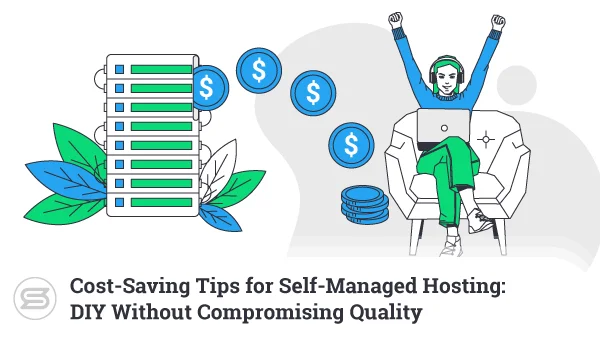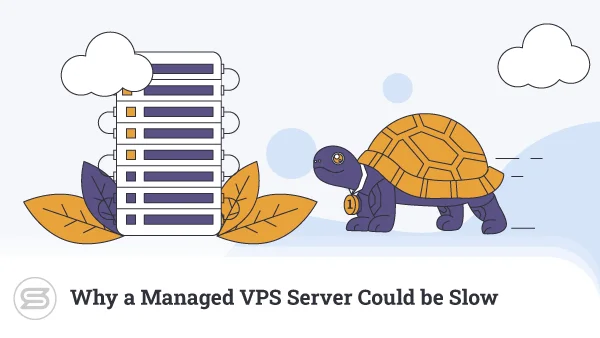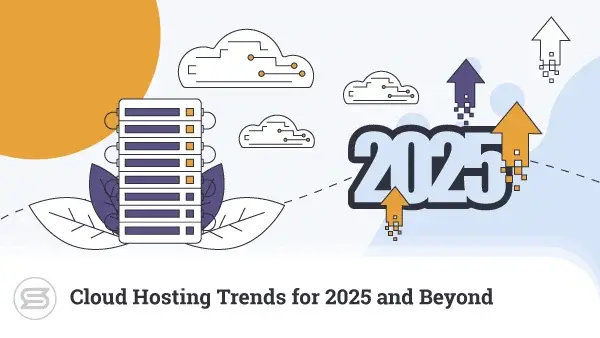The costs of buying and maintaining a web hosting server are enormous. These machines use expensive, enterprise-grade hardware, and they can’t work outside the carefully controlled environment of a data center.
Yet, if you choose a shared or a VPS hosting plan, you don’t need to rob a bank to host your website.
Let’s see how hosting providers manage to keep the prices affordable and how the two types of services stack up against each other.

What is Shared Hosting?
Shared hosting has enabled thousands of people from all walks of life to start their own websites. That’s because it’s very cheap.
In a shared hosting setup, hundreds of websites are hosted on the same server. Their owners share the costs of running the machine, and that’s how hosting providers manage to keep the prices as low as a few dollars per month.
You, along with the rest of the people hosting their projects on the shared server, use the same hardware at the same time. Depending on the plan, you will have some limits on the amount of computational power you can use, and if you start to exceed them, your host’s support team will notify you about it.
For the most part, a shared server should be powerful enough to support many low-traffic websites running simultaneously, so if you’re just getting started, a shared plan may be exactly what you’re looking for.
Another advantage for the novices among you is the user-friendly control panel you usually get with a shared account. Through it, you can set up email and FTP accounts, install a content management system, create and manage files and databases, and many more. All this functionality is wrapped in an easy-to-use Graphical User Interface (GUI), and you get access to it as soon as you set up the account.
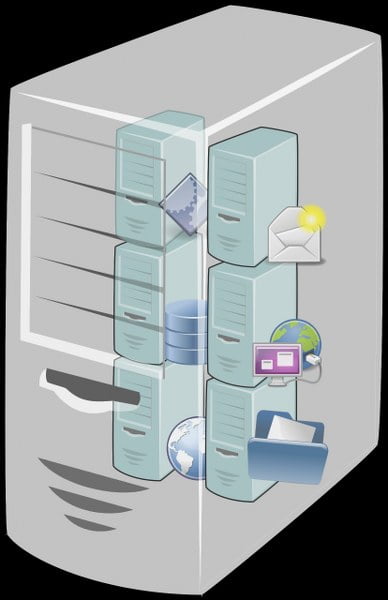
What is VPS hosting?
VPS hosting also involves putting multiple accounts on the same physical server. However, this time, the number of people using the same machine is much lower, meaning VPS plans are more expensive than shared ones. This is far from the only difference.
VPS stands for Virtual Private Server. Hosting providers use virtualization technology to effectively split a physical server into smaller virtual ones. With a VPS account, you get one of the virtual servers all to yourself.
A virtual server is designed to work like a physical one. It has an operating system, it’s possible to install software on it, and it has its own hardware configuration.
Although it co-exists with other VPSs on the same physical machine, your virtual server is completely isolated from them. It even has its own dedicated IP.
When you’re choosing a VPS plan, you can decide how involved you want to be in maintaining your virtual machine.
There are two options:
- A self-managed VPS plan provides you with a bare-metal virtual machine. Your host will install an operating system and will give you root access to it. It’s up to you to set up and configure the rest of the software you need to create the environment you’re after.
- A managed VPS is a much better choice if you want to start working on your website immediately. You get a virtual server set up and ready to provide a hosting environment for your website. A browser-based management platform gives you access to all the tools you need to control the server and the projects hosted on it.
When your website gains popularity and you outgrow the shared plan you’ve started on, your host will likely recommend upgrading to a VPS account.
Shared Hosting vs. VPS hosting – 7 Key Differences You Should Know
If you don’t delve into the details, you might be forgiven for thinking that the only difference between shared and VPS hosting is the number of accounts situated on the same physical server. This couldn’t be further from the truth.
We’re talking about two distinct setups with many differences between them. Let’s explore some of them.
Resource Allocation
On a shared server, resources are provided on an as-needed basis. If one of the websites hosted on it experiences a traffic spike, the server will most likely handle the higher number of requests, no problem at all.
If, however, many websites start hogging the system resources simultaneously, you could end up with a scenario where there’s no computational power left for you. This immediately results in compromised performance and, in extreme situations, downtime.
The VPS setup is different. You get your own server with its own set of hardware resources. If your plan gives you 2 CPU cores, 4GB of RAM, and 20GB of disk space, you can be sure that they are available to you 24/7.
The isolated virtual environment of a VPS means that other accounts hosted on the same physical machine can’t affect your website’s performance in any way.

Security
In a shared environment, account owners log into the same server with different sets of login credentials. They have their separate accounts, and a properly configured server should provide sufficient isolation, so a compromise of one account shouldn’t present a problem for the rest.
Cyberattacks that have managed to cripple entire shared servers are not unheard of, though. A DDoS campaign against a single website will affect the performance of the whole server, and other sites will inevitably suffer as well.
This isn’t a problem with a VPS. Virtualization technology means that while hackers can attack a virtual server all they want, they can’t get to the underlying infrastructure. An attack on one of your neighboring VPSs can’t affect you.
Performance
Overselling has always been a problem of shared hosting. Some hosting companies tend to put too many accounts on their shared servers. A part of them do it intentionally, in an attempt to maximize their profits, and others just lack the experience to know where the limits are. The effects in both cases, however, are the same – a server that is under too much load and compromised performance for everyone on the machine.
In other words, even if your website displays decent speeds at the moment, this could quickly change if your host decides to stuff the server with resource-hogging websites.
With a VPS, this isn’t really a problem. Because of the guaranteed resources, it’s practically impossible to oversell a physical machine running VPSs, so you needn’t worry about an excessive number of websites slowing your server down. Your project’s loading speed is entirely dependent on how you utilize the hardware resources you’re given.
Configuration and Customization
Shared hosting accounts are optimized to provide low-traffic websites with everything they need. Because they are extensively used by people who have no web development experience, they are designed to be as novice-friendly as possible.
If your project requires a more specific setup, however, shared plans are not your best bet.
You get minimal access to the account’s actual setup, and you can’t install additional tools or set custom configurations. Your host won’t be terribly eager to make specific changes for you, either. The shared environment means that a custom setup on your account may affect other users on the server, which isn’t ideal if you want to keep hundreds of websites running smoothly.
VPS hosting offers much more freedom when it comes to setting up the hosting environment.
If you get a self-managed solution, you have root access, and you can do pretty much anything you want. In effect, the virtual server is at your disposal, so you can install additional software, apply custom configurations to your system’s settings, and do whatever you want to ensure the VPS is set to your exact specifications.
Even with a managed VPS, your host may be willing to help you out with some of the more specific requests. Because of the isolated environment, any tweaks to your server won’t affect other users.

Scalability
On a shared hosting account, lifting the limits of your plan is relatively easy, but this style of hosting and the tools that support it have never been designed to cater to popular websites. If your project is headed in the right direction, you will sooner or later reach the limit of shared hosting.
Reaching the limit of your VPS will be much more difficult. A virtual server is endlessly configurable, and adding or removing resources is often a two-click job.
Your host has the means to ensure you can always add more hardware, and to give you additional flexibility, some providers will even let you change individual components. So, if the CPU is creating a bottleneck, you can simply add another virtual processor core without changing the RAM or the storage space. This way, you only pay for resources you need and use.
Customer Service
Your host’s customer care and technical support team are there to help you with any questions or problems related to your hosting service.
With a shared hosting account, the number of things that could go wrong is relatively limited, and the tools you use to control the service are designed to be as user-friendly as possible. In other words, the chances of finding yourself in a situation where you don’t know what to do are slim.
A VPS, however, is a more complex environment. You have more things to think about, and you can encounter more terms and concepts you’re not familiar with. A good host will have an experienced team of support specialists who can quickly and efficiently assist you whenever you get stuck.

Price
VPS hosting will always be more expensive than shared hosting. Deploying the virtual server is a much more complicated process, and keeping it going requires a lot more work from your host’s technical experts.
That said, for years now, hosting providers have been trying to narrow the price gap between the two services. Through innovation, for example, at ScalaHosting, we succeeded in bringing our managed VPS plans much closer to the shared accounts than they would normally be.
This is all thanks to SPanel – an all-in-one management platform that lets you control all aspects of your VPS service. We developed it ourselves, and we tailored it to our own VPS environment. As our client, you won’t need to pay any licensing fees for it, meaning you can get a fully-managed feature-packed VPS at an incredibly competitive price.
When Should You Switch From Shared Hosting to VPS Hosting?
Your website may be slowing down due to many different reasons, and you need to make sure you investigate the issue as soon as you notice it. Your shared plan’s control panel likely has a tool showing you how much load the account is under. If you’re putting a lot of strain on the service, you probably need to upgrade to a more powerful solution.
Reaching the limit of your shared plan is not the only reason for upgrading to a VPS, though.
For example, on a shared plan, you share not only the server’s hardware resources but also its IP address. If another person on the same shared server starts sending spam, the IP will soon be blacklisted, and all emails coming from it will be blocked or sent to the recipient’s Junk folder.
Given how many people you share the server with, the chances of someone misbehaving aren’t that slim. If email communication is important for your business, moving to a VPS option with a dedicated IP makes a lot of sense.
There are yet more reasons for upgrading to a virtual server. You may even consider starting on a VPS and not bothering with a shared account at all if you have the budget and want to ensure decent performance for the foreseeable future.

ScalaHosting Shared to VPS Hosting Migrations
Although VPS hosting has always been central to our portfolio of services, at ScalaHosting, we understand that most website owners prefer the cheapest option in the early stages of their projects. That’s why we have a selection of three shared hosting plans that should give smaller websites the ability to grow without draining their owners’ bank accounts.
We sincerely hope that you manage to develop a website that is too popular for a shared plan, and we want to make sure that when you need to upgrade to a VPS solution, the transition will be as seamless as possible.
That’s why if you choose to upgrade to one of our managed VPS solutions, we will migrate everything for you completely free of charge. Even if you are currently hosting with another provider, if you contact our technical support team and give them the login credentials, they will transfer the data and ensure everything works fine before notifying you that the migration is successful.
During the migration, you can have your domain pointed at your old account. That way, you can make the switch without a single second of downtime.

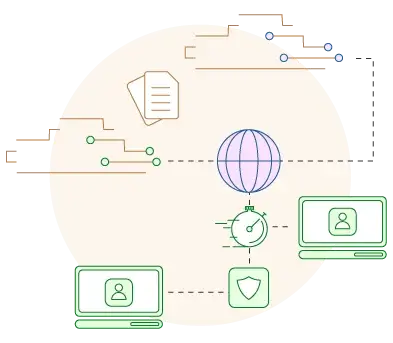
Conclusion
VPS and shared hosting are much more affordable than expensive alternatives like dedicated servers or cloud hosting services. Chances are, these are the two options you will consider when choosing a hosting service for your project.
Although they appear similar, and although the price gap is not as wide as it used to be, you need to make a clear distinction between the two because they can give you completely different experiences. Choosing the best one for you means familiarizing yourself with how they work and what they offer.
FAQ
Q: Is VPS faster than shared hosting?
A: VPS hosting plans tend to give you more hardware power than the shared alternatives. More importantly, with a virtual server, you can be sure that the resources are available all the time and that other accounts won’t affect your website’s performance. That’s why a VPS is better suited to hosting sites that need consistent performance even under higher traffic levels.
Q: Is VPS hosting better?
A: A shared hosting account may just be good enough to host a small website with relatively low traffic volumes. A VPS is a more powerful solution better suited for websites that have a higher number of visitors and need to display consistent performance at all times.
Q: What is the difference between a VPS and a dedicated server?
A: With a dedicated server, you get an entire physical server all to yourself. In terms of power, it’s pretty hard to match, but it’s a costly solution that is out of reach for most website owners.
A VPS is designed to act as a regular dedicated server. It’s less powerful than a physical machine, but it’s also much cheaper, easier to scale, and more flexible.
What is a VPS – Everything you need to know!

